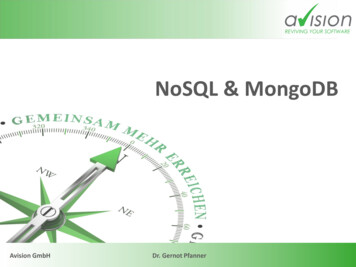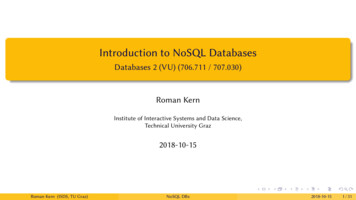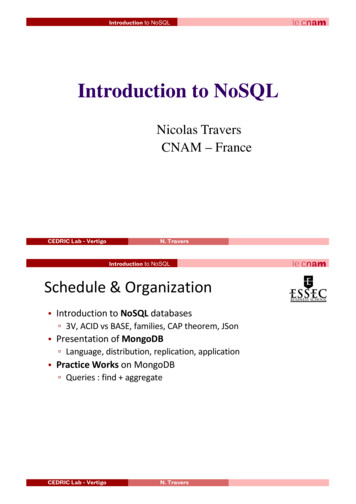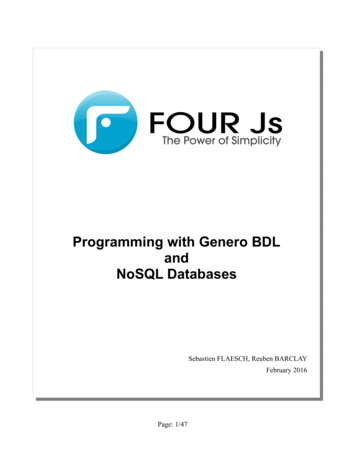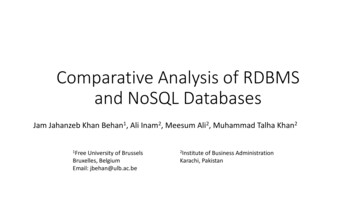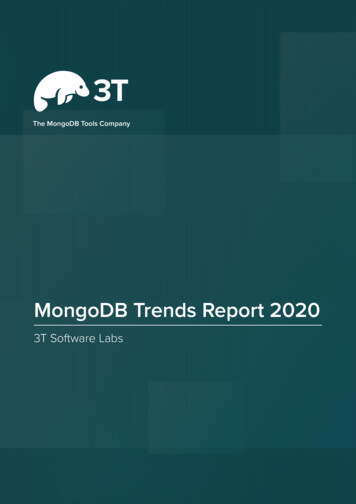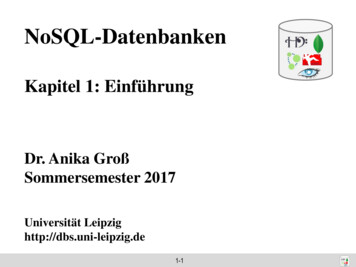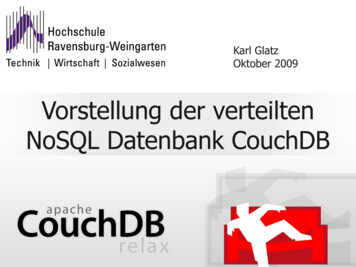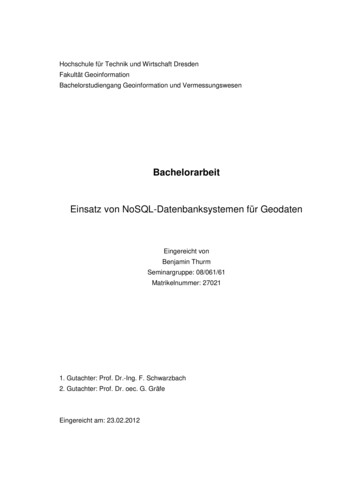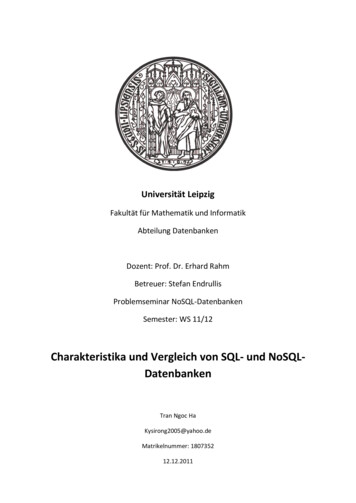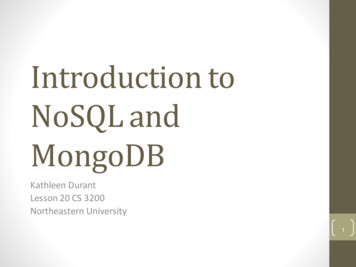
Transcription
Introduction toNoSQL andMongoDBKathleen DurantLesson 20 CS 3200Northeastern University1
Outline for today Introduction to NoSQL Architecture Sharding Replica sets NoSQL Assumptions and the CAP Theorem Strengths and weaknesses of NoSQL MongoDB Functionality Examples2
Taxonomy of NoSQL Key-value Graph database Document-oriented Column family3
Typical NoSQL architectureKHashingfunction mapseach key to aserver (node)4
CAP theorem for NoSQLWhat the CAP theorem really says: If you cannot limit the number of faults and requests can bedirected to any server and you insist on serving every request youreceive then you cannot possibly be consistentEric Brewer 2001How it is interpreted: You must always give something up: consistency, availability ortolerance to failure and reconfiguration5
Theory of NOSQL: CAPCGIVEN: Many nodes Nodes contain replicas of partitionsof the data Consistency All replicas contain the same versionof data Client always has the same view ofthe data (no matter what node) Availability System remains operational on failingnodes All clients can always read and write Partition tolerance multiple entry points System remains operational onsystem split (communicationmalfunction) System works well across physicalnetwork partitionsAPCAP Theorem:satisfying all three at thesame time is impossible6
Available, PartitionTolerant (AP) Systemsachieve "eventualconsistency" throughreplication andverificationConsistent,Available (CA)Systems havetrouble withpartitionsand typically dealwith it withreplicationConsistent, Partition-Tolerant (CP)Systems have trouble with availabilitywhile keeping data consistent acrosspartitioned l-systems
Sharding of data Distributes a single logical database system across a cluster ofmachines Uses range-based partitioning to distribute documents basedon a specific shard key Automatically balances the data associated with each shard Can be turned on and off per collection (table)8
Replica Sets Redundancy and Failover Zero downtime forupgrades andmaintenance Master-slave replication Strong Consistency Delayed Consistency Geospatial lient9
How does NoSQL vary fromRDBMS? Looser schema definition Applications written to deal with specific documents/ data Applications aware of the schema definition as opposed to the data Designed to handle distributed, large databases Trade offs: No strong support for ad hoc queries but designed for speed andgrowth of database Query language through the API Relaxation of the ACID properties10
Benefits of NoSQLElastic Scaling RDBMS scale up – biggerload , bigger server NO SQL scale out –distribute data acrossmultiple hostsseamlesslyBig Data Huge increase in dataRDMS: capacity andconstraints of datavolumes at its limits NoSQL designed for bigdataDBA Specialists RDMS require highlytrained expert tomonitor DB NoSQL require lessmanagement, automaticrepair and simpler datamodels11
Benefits of NoSQLFlexible data models Change management toschema for RDMS haveto be carefully managed NoSQL databases morerelaxed in structure ofdata Database schemachanges do not have tobe managed as onecomplicated change unit Application alreadywritten to address anamorphous schemaEconomics RDMS rely on expensiveproprietary servers tomanage data No SQL: clusters ofcheap commodityservers to manage thedata and transactionvolumes Cost per gigabyte ortransaction/second forNoSQL can be lowerthan the cost for aRDBMS12
Drawbacks of NoSQL Support RDBMS vendorsprovide a high level ofsupport to clients Stellar reputation NoSQL – are opensource projects withstartups supportingthem Reputation not yetestablished Maturity RDMS matureproduct: means stableand dependable Also means old nolonger cutting edge norinteresting NoSQL are stillimplementing theirbasic feature set13
Drawbacks of NoSQL Administration RDMS administrator welldefined role No SQL’s goal: noadministrator necessaryhowever NO SQL stillrequires effort tomaintain Lack of Expertise Whole workforce oftrained and seasonedRDMS developers Still recruitingdevelopers to the NoSQLcamp Analytics and BusinessIntelligence RDMS designed toaddress this niche NoSQL designed to meetthe needs of an Web 2.0application - notdesigned for ad hocquery of the data Tools are beingdeveloped to addressthis need14
RDB ACID to NoSQL BASEAtomicityBasicallyConsistencyAvailable (CP)IsolationSoft-state(State of system may changeover time)DurabilityEventuallyconsistent(Asynchronous propagation)Pritchett, D.: BASE: An Acid Alternative (queue.acm.org/detail.cfm?id 1394128)15
First example:16
What is MongoDB? Developed by 10gen Founded in 2007 A document-oriented, NoSQL database Hash-based, schema-less database No Data Definition Language In practice, this means you can store hashes with any keys and valuesthat you choose Keys are a basic data type but in reality stored as strings Document Identifiers ( id) will be created for each document, field namereserved by system Application tracks the schema and mapping Uses BSON format Based on JSON – B stands for Binary Written in C Supports APIs (drivers) in many computer languages JavaScript, Python, Ruby, Perl, Java, Java Scala, C#, C , Haskell,Erlang17
Functionality of MongoDB Dynamic schema No DDL Document-based databaseSecondary indexesQuery language via an APIAtomic writes and fully-consistent reads If system configured that way Master-slave replication with automated failover (replica sets) Built-in horizontal scaling via automated range-basedpartitioning of data (sharding) No joins nor transactions18
Why use MongoDB? Simple queries Functionality provided applicable to most web applications Easy and fast integration of data No ERD diagram Not well suited for heavy and complex transactions systems19
MongoDB: CAP approachCFocus on Consistencyand Partition tolerance Consistency all replicas contain the sameversion of the data Availability system remains operational onfailing nodes Partition tolarence multiple entry points system remains operational onsystem splitAPCAP Theorem:satisfying all three at the same time isimpossible20
MongoDB: Hierarchical Objects A MongoDB instancemay have zero or more‘databases’ A database may havezero or more‘collections’. A collection may havezero or more‘documents’. A document may haveone or more ‘fields’. MongoDB ‘Indexes’function much like theirRDBMS counterparts.0 or more Databases0 or moreCollections0 or moreDocuments0 ormoreFields21
RDB Concepts to NO SQLRDBMSMongoDBDatabaseDatabaseTable, ViewCollectionRowDocument (BSON)ColumnFieldIndexIndexJoinEmbedded DocumentForeign KeyReferenceCollection is notstrict about what itStoresSchema-lessHierarchy is evidentin the designEmbeddedDocument ?22PartitionShard
MongoDB Processes andconfiguration Mongod – Database instance Mongos - Sharding processes Analogous to a database router.Processes all requestsDecides how many and which mongods should receive the queryMongos collates the results, and sends it back to the client. Mongo – an interactive shell ( a client) Fully functional JavaScript environment for use with a MongoDB You can have one mongos for the whole system no matterhow many mongods you have OR you can have one local mongos for every client if youwanted to minimize network latency.23
Choices made for Design ofMongoDB Scale horizontally over commodity hardware Lots of relatively inexpensive servers Keep the functionality that works well in RDBMSs– Ad hoc queries– Fully featured indexes– Secondary indexes What doesn’t distribute well in RDB?– Long running multi-row transactions– Joins– Both artifacts of the relational data model (row x column)24
BSON format Binary-encoded serialization of JSON-like documentsZero or more key/value pairs are stored as a single entityEach entry consists of a field name, a data type, and a valueLarge elements in a BSON document are prefixed with alength field to facilitate scanning25
Schema Free MongoDB does not need any pre-defined data schemaEvery document in a collection could have different data Addresses NULL data fields{name: “will”,eyes: “blue”,birthplace: “NY”,aliases: [“bill”, “la ciacco”],loc: [32.7, 63.4],boss: ”ben”}name: “jeff”,eyes: “blue”,loc: [40.7, 73.4],boss: “ben”}name: “ben”,hat: ”yes”}{name: “brendan”,aliases: [“el diablo”]}{name: “matt”,pizza: “DiGiorno”,height: 72,loc: [44.6, 71.3]}
JSON format Data is in name / value pairs A name/value pair consists of a field name followedby a colon, followed by a value: Example: “name”: “R2-D2” Data is separated by commas Example: “name”: “R2-D2”, race : “Droid” Curly braces hold objects Example: {“name”: “R2-D2”, race : “Droid”, affiliation:“rebels”} An array is stored in brackets [] Example [ {“name”: “R2-D2”, race : “Droid”, affiliation:“rebels”}, {“name”: “Yoda”, affiliation: “rebels”} ]
MongoDB Features Document-Oriented storage Full Index Support Replication & HighAvailability Auto-Sharding Querying Fast In-Place Updates Map/Reduce functionalityAgileScalable28
Index Functionality B tree indexes An index is automatically created on the id field (the primarykey) Users can create other indexes to improve query performanceor to enforce Unique values for a particular field Supports single field index as well as Compound index Like SQL order of the fields in a compound index matters If you index a field that holds an array value, MongoDB createsseparate index entries for every element of the array Sparse property of an index ensures that the index onlycontain entries for documents that have the indexed field. (soignore records that do not have the field defined) If an index is both unique and sparse – then the system willreject records that have a duplicate key value but allowrecords that do not have the indexed field defined29
CRUD operations Create db.collection.insert( document ) db.collection.save( document ) db.collection.update( query , update , { upsert: true } ) Read db.collection.find( query , projection ) db.collection.findOne( query , projection ) Update db.collection.update( query , update , options ) Delete db.collection.remove( query , justOne )Collection specifies the collection or the‘table’ to store the document30
Create OperationsDb.collection specifies the collection or the ‘table’ to store thedocument db.collection name.insert( document ) Omit the id field to have MongoDB generate a unique key Example db.parts.insert( {{type: “screwdriver”, quantity: 15 } ) db.parts.insert({ id: 10, type: “hammer”, quantity: 1 }) db.collection name.update( query , update , { upsert: true } ) Will update 1 or more records in a collection satisfying query db.collection name.save( document ) Updates an existing record or creates a new record31
Read Operations db.collection.find( query , projection ).cursor modified Provides functionality similar to the SELECT command query where condition , projection fields in result set Example: var PartsCursor db.parts.find({parts:“hammer”}).limit(5) Has cursors to handle a result set Can modify the query to impose limits, skips, and sort orders. Can specify to return the ‘top’ number of records from the resultset db.collection.findOne( query , projection )32
Query OperatorsNameDescription eqMatches value that are equal to a specified value gt, gteMatches values that are greater than (or equal to a specified value lt, lteMatches values less than or ( equal to ) a specified value neMatches values that are not equal to a specified value inMatches any of the values specified in an array ninMatches none of the values specified in an array orJoins query clauses with a logical OR returns all andJoin query clauses with a loginal AND notInverts the effect of a query expression norJoin query clauses with a logical NOR existsMatches documents that have a specified rator/query/33
Update Operations db.collection name.insert( document ) Omit the id field to have MongoDB generate a unique key Example db.parts.insert( {{type: “screwdriver”, quantity: 15 } ) db.parts.insert({ id: 10, type: “hammer”, quantity: 1 }) db.collection name.save( document ) Updates an existing record or creates a new record db.collection name.update( query , update , { upsert: true } ) Will update 1 or more records in a collection satisfying query db.collection name.findAndModify( query , sort , update , new , fields , upsert ) Modify existing record(s) – retrieve old or new version of the record34
Delete Operations db.collection name.remove( query , justone ) Delete all records from a collection or matching a criterion justone - specifies to delete only 1 record matching the criterion Example: db.parts.remove(type: / h/ } ) - remove all parts startingwith h Db.parts.remove() – delete all documents in the parts collections35
CRUD examples db.user.insert({first: "John",last : "Doe",age: 39}) db.user.find (){ " id" : ObjectId("51"),"first" : "John","last" : "Doe","age" : 39} db.user.update({" id" : ObjectId(“51")},{ set: {age: 40,salary: 7000}}) db.user.remove({"first": / J/})36
SQL vs. Mongo DB entitiesMy SQLSTART TRANSACTION;INSERT INTO contacts VALUES(NULL, ‘joeblow’);INSERT INTO contact emailsVALUES( NULL, ”joe@blow.com”,LAST INSERT ID() ),( NULL,“joseph@blow.com”,LAST INSERT ID() );COMMIT;Mongo DBdb.contacts.save( {userName: “joeblow”,emailAddresses: [“joe@blow.com”,“joseph@blow.com” ] });Similar to IDS from the 70’sBachman’s brainchildDIFFERENCE:MongoDB separates physical structurefrom logical structureDesigned to deal with large &distributed37
Aggregated functionalityAggregation framework
MongoDB: Hierarchical Objects A MongoDB instance may have zero or more Zdatabases [ A database may have zero or more Zcollections [. A collection may have zero or more Zdocuments [. A document may have one or more fields [. MongoD Indexes function much like their RDBMS counterparts. 21 0 or more Fields 0 or more Documents 0 or more
